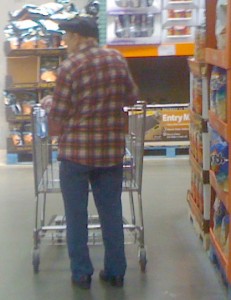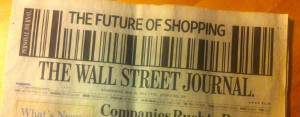Will point of sale influence point of care?
June 6, 2011 | In: I've Been Thinking
I’ve been thinking about pops, mobility, POPs, and opportunity.
My pops is 90, and his mobility is waning—though he’s yet to entertain the idea of using a walker. He loves outings to Costco but navigating a shopping cart through the aisles is increasingly difficult. I’ve offered to push but discovered it’s better if he drives, as the cart steadies his balance. Remember, it’s a cart, not a walker. Oh, I get it. Pity my kids.
 Technologically, Pops advanced as far as the IBM Selectric—the model before the one featuring whiteout tape. He didn’t get a touch-tone phone until the late ‘90s (in Los Angeles, no less). Remember how painful it was to wait for dials to return from 0s, 8s, and 9s? He’s never had a cell phone, touched a computer keyboard, or clicked a mouse.
Technologically, Pops advanced as far as the IBM Selectric—the model before the one featuring whiteout tape. He didn’t get a touch-tone phone until the late ‘90s (in Los Angeles, no less). Remember how painful it was to wait for dials to return from 0s, 8s, and 9s? He’s never had a cell phone, touched a computer keyboard, or clicked a mouse.
He does OK with ATM’s and regularly swipes plastic credit, loyalty, and ID cards on Rite Aide and Kaiser visits. And when I talk about the process and value of scanning bar codes on patients and medications at the point of care, he sees it as a no-brainer.
Though scanning bar codes at retail stores began in the mid-1970s, the points of purchase (POPs) for brick-and-mortars have remained immovable at the front of the stores—until now.
At about the same pace as my pop’s diminishing mobility, POPs mobility is increasing. Been to an Apple Store lately? Checkout stands have disappeared. Instead, a specialist meets me where I am with an iPod Touch to scan my purchase and swipe my credit card. The receipt arrives on my iPhone before I head for Nordstrom two doors away.
The May 18, 2011 edition of the Wall Street Journal (WSJ) has a huge bar code spanning its masthead topped by the title of the editor’s recommended article: “The Future of Shopping.”
Unlike those future-of articles I read in 1960s Popular Mechanics (featuring technologies which haven’t yet and never will arrive), the POP technologies featured in the WSJ article are already here and spreading. “Retail experts predict the new retail gizmos could eventually bring about the end of traditional cash registers.”
Over at Nordstrom, for example, sales associates are outfitted with handhelds. With a simple scan, the store’s inventory can be searched for a garment in a size a customer is requesting. Shoppers pay on the spot. No need to find or wait at cash registers. Home Depot is following suit.
That’s not all. WSJ says, “Retail experts predict that before long most of these mobile shopping gadgets will be supplanted by customers’ own smart phones.”
Last week in Minneapolis, a physician handed me a copy of Daniel Pink’s Drive: The Surprising Truth About What Motivates Us, saying it’s a “must read.” Opening Red Laser’s app on my iPhone, I scanned the bar code on the cover and purchased the best seller before I left his office.
I believe these trends will help pave the way for more rapid adoption of bar-code technology in our hospitals. Not a few nurses, who might have resisted point-of-care bar coding a few years ago, now appreciate quick sales at Nordstrom and use bar-code scanning apps like mine on their phones. Red Laser, just one such app, has been downloaded by more than nine million people.
“If the technology takes off,” the WSJ article suggests, “it could become a new opportunity for stores to shrink payrolls. For now, though, most say they see it as an opportunity to free up workers to provide more customer services.”
I have a hospital client whose pharmacy still uses the eyeball-pencil-paper method to manage drug inventory—a labor-intensive approach that results in over- and under-stocking medications, inventory turns that are not optimized, and time wasted while hunting, gathering, and tracking product. We’ve helped them see bar-code-enabled inventory tracking as an opportunity for significant labor savings.
Will the hospital see this as a new opportunity to shrink payroll or as an opportunity to free workers to provide additional pharmacy services? Apple has reallocated cashier time saved to customer service—one reason they have become one of the most successful retailers in history.
I’m thinking of taking Pops to an Apple Store. I can hear him now, “How does a guy pay for something in here?” I know he’d like the answer. The shopping cart could be a problem.
What do you think?
Mark Neuenschwander a.k.a. Noosh
mark@hospitalrx.com
http://twitter.com/hospitalrx
Copyright 2011 The Neuenschwander Company

